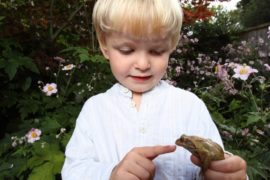This award-winning documentary of one father’s desperate search for a way to help a generation of children reconnect with nature takes many twists and turns. The film opens with a scene where David Bond experiences quite a battle with his young children who are not interested in leaving their captivating screens to go outside to play. After creating a pie chart with his children’s daily activities, David realized that his children were only spending 4% of their time outside in nature. Having fond memories of his own outdoor fun as a child, David appointed himself “Marketing Director for Nature” and what resulted is this film Project Wild Thing. Bond’s creative genius combined with a team of Britain’s top marketing professionals was awakened and set to an important task – to help parents and children reconnect with nature. Billboard ads, articles, a media-blitz, websites, apps, and grassroots endeavors provide a variety of opportunities to raise awareness on this important issue.
With all of the demands of our modern world screaming at us all of the time, is it any wonder that families opt for quiet indoor activities to counteract the noise, hustle and bustle? Alarms buzzing all too early, and the ever-present pressure of getting things done in accordance with predetermined schedules can leave parents feeling exhausted. When the weekend comes, who has the energy to pile everyone into the car and head for the mountains to hike? Wouldn’t it be easier to enjoy nature, simply by watching something on the Discovery Channel? Birds are part of nature so isn’t it enough that the children love playing Angry Birds on my iPhone? There are lots of captivating scenery in the Star Wars sagas and the latest Disney and Pixar movies are taking up environmental issues – couldn’t that help my child feel connected to nature while I get a little necessary downtime? Everyone’s doing it and I wouldn’t want my children to feel left out or disconnected from other children. What’s the harm anyway? These are common feelings expressed by parents when the topic of screen time is brought up.
Perhaps the first thing to consider is what children aren’t doing when they are sitting in front of screens….they aren’t moving. Why is that an important consideration? Did you know that neurological pathways must be created in our brains so that our nervous system can detect and control our body’s movement in a coordinated manner? According to Eric Jensen in Teaching with the Brain in Mind, the development of our sensory-motor system creates scaffolding for more advanced brain development and is the foundation for reading, writing, and reasoning. So, while we could postpone activities that demand physical activity and coordination for another day, we may very well be sacrificing the development of this important scaffolding in our children’s brains. In fact, Eric Jensen goes further to say that there are four critical areas of development in young children: emotions, sensory motor, auditory, and vision.
In fact, as a Waldorf Educational Support Specialist and Class Teacher I can say without hesitation that learning and behavioral problems observed in the classroom almost always have their root in developmental delays and deficits in at least one of these four critical areas that Jensen mentions. In Healing Our Children with Attentional, Emotional and Learning Challenges, Susan Johnson, MD, FAAP draws a strong correlation between a child’s vestibular system (sense of balance and muscle tone) to auditory processing, which is directly related to learning and emotional health. The development of our proprioception (ability to sense where we are – spatial awareness) is not only a factor in our sense of wellbeing and capacity to adapt to our changing environment, but also our capacity to sustain our focus as we follow the movement of lines and curves when we read or pursue academic learning.
In Waldorf schools around the world, nursery and kindergarten teachers strive to provide healthy environments for children to explore their world through movement and play. As children approach 6 years of age, their teachers often begin a First Grade Readiness Screening, which allows them to take a closer look at the child’s early development and ascertain what supports can help to transition the child into first grade. A more extensive screening is often performed in the second grade in order to provide the Class Teacher with guidance as he/she prepares to transition the class into the middle grades (3rd-5th grade). It may come as no surprise to hear that both of these screenings are focused on the very same criteria mentioned above, i.e. sensory motor, auditory, visual, vestibular, and proprioception development. As a Waldorf Educational Support Specialist, it is this foundational level that I am most interested to learn about and support when there are questions about a student’s academic or social growth. For, truly only by addressing the root cause of a child’s inability or challenge to learning can sustained change be expected for the child. Classroom modifications, educational plans, and tutoring provide initial support, but without addressing the deficits in this brain scaffolding, we are simply perpetuating the need for such supports.
What does nature provide for growing children and their developing brains? When we leave behind the smooth sidewalks, paved parking lots, tile or carpeted floors and opt for a sandy wash or a grassy park or the uneven terrain of a hiking trail, our nervous system must develop stronger and more robust capacities for proprioception, balance, and coordination of our sensory motor system. When we observe more directly the cycles of nature, we feel more connected to the rhythms inherent in life and this has a calming effect on our nervous system, providing a sense of wellbeing. Experiencing the changing light as daylight fades with the setting sun and gazing at the night sky provide opportunities for our visual system to shift between focused vision and peripheral vision. Listening to the wind rustling the leaves or the chirping of birds allows our auditory system to reset itself and develop an acute and finely honed capacity to distinguish nuances of sound. As our brains are challenged to process a variety of natural sights, sounds, smells, feelings, and sensations, especially when movement is involved, we find ourselves taking deeper breaths and feeling more at ease while we deepen our children’s experience of the world and strengthen their neurological foundations.
Over the next month, I challenge each and every member of our school community to increase their time in nature – from the back yard to the park to the mountains to the desert. Notice something new about the lizard as it runs across the wall or the butterfly’s choice of flowers. Ride a bike, splash across a creek on a hike, or watch the sun rise. The possibilities are endless. Take a closer look at your total screen time and that of your children – match that time with time spent exploring nature.
~Michelle Blazewicz,
Tucson Waldorf School

